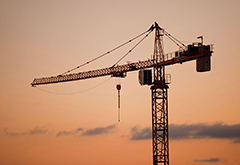1. Large Hadron Collider:
Bucket-wheel excavators (BWEs) are heavy equipment used in surface mining. The primary function of BWEs is to act as a continuous digging machine in large-scale open-pit mining operations. What sets BWEs apart from other large-scale mining equipment, such as bucket chain excavators, is their use of a large wheel consisting of a continuous pattern of buckets used to scoop material as the wheel turns. They are among the largest vehicles ever constructed, and the biggest bucket-wheel excavator ever built, Bagger 293, is the largest terrestrial (land) vehicle in history by weight (14,200 tonnes), according to the Guinness Book of World Records. More details
3. Saturn V Rocket:
4. Tunnel Boring Machine:
5. Metso 4265 Gyratory Crusher:
6. Rotary Snow Plow:
7. ITER (Nuclear Fusion Project):
8. Crawler Transporter:
The crawler-transporters, formally known as the Missile Crawler Transporter Facilities, are a pair of tracked vehicles used to transport spacecraft from NASA's Vehicle Assembly Building (VAB) along the Crawlerway to Launch Complex 39. They were originally used to transport the Saturn IB and Saturn V rockets during the Apollo, Skylab and Apollo–Soyuz programs. They were then used to transport Space Shuttles from 1981 to 2011. The crawler-transporters carry vehicles on the Mobile Launcher Platform, and after each launch return to the pad to take the platform back to the VAB. More details
9. LeTourneau L-2350 Loader:
10. Self-Propelled Modular Transporter:
A self-propelled modular transporter or sometimes self-propelled modular trailer (SPMT) is a platform vehicle with a large array of wheels. SPMTs are used for transporting massive objects such as large bridge sections, oil refining equipment, motors and other objects that are too big or heavy for trucks. Trucks can however provide traction and braking for the SPMTs on inclines and descents. SPMTs are used in many industry sectors worldwide such as the construction and oil industries, in the shipyard and offshore industry, for road transportation, on plant construction sites and even for moving oil platforms. Recently in addition, they have begun to be used to replace bridge spans in the United States, Europe, Asia and more recently Canada. More details
The Komatsu 930E is an off-highway, ultra class, rigid frame, two-axle, diesel/AC electric powertrain haul truck designed and manufactured by Komatsu in Peoria, Illinois, United States. Although the 930E is neither Komatsu's largest nor highest payload capacity haul truck, Komatsu considers the 930E to be the flagship of their haul truck product line. The 930E is the best selling ultra class haul truck in the world. As of September 2016, Komatsu has sold 1,900 units of 930E. The current model, the 930E-5 offer a payload capacity of up to 320 short tons (290 t). More details
The Space Shuttle was a partially reusable low Earth orbital spacecraft system that was operated from 1981 to 2011 by the U.S. National Aeronautics and Space Administration (NASA) as part of the Space Shuttle program. Its official program name was Space Transportation System (STS), taken from a 1969 plan for a system of reusable spacecraft of which it was the only item funded for development. The first of four orbital test flights occurred in 1981, leading to operational flights beginning in 1982. In addition to the prototype whose completion was cancelled, five complete Shuttle systems were built and used on a total of 135 missions from 1981 to 2011. More details
The International Space Station (ISS) is a modular space station (habitable artificial satellite) in low Earth orbit. The ISS programme is a multi-national collaborative project between five participating space agencies: NASA (United States), Roscosmos (Russia), JAXA (Japan), ESA (Europe), and CSA (Canada). The ownership and use of the space station is established by intergovernmental treaties and agreements. The ISS serves as a microgravity and space environment research laboratory in which scientific experiments are conducted in astrobiology, astronomy, meteorology, physics, and other fields. More details
13. International Space Station:
14. Five Hundred Meter Aperture Spherical Telescope:
The Five-hundred-meter Aperture Spherical radio Telescope (FAST) is a radio telescope located in the Dawodang depression, a natural basin in Pingtang County, Guizhou, southwest China. FAST has a 500 m diameter dish constructed in a natural depression in the landscape. It is the world's largest filled-aperture radio telescope and the second-largest single-dish aperture, after the sparsely-filled RATAN-600 in Russia. It has a novel design, using an active surface made of 4,500 panels to form a moving parabola metal panels in real time. The cabin containing the feed antenna, suspended on cables above the dish, can move automatically by using winches to steer the instrument to receive signals from different directions. More details
15. Cranes:
A crane is a type of machine, generally equipped with a hoist rope, wire ropes or chains, and sheaves, that can be used both to lift and lower materials and to move them horizontally. It is mainly used for lifting heavy things and transporting them to other places. The device uses one or more simple machines to create mechanical advantage and thus move loads beyond the normal capability of a human. Cranes are commonly employed in the transport industry for the loading and unloading of freight, in the construction industry for the movement of materials, and in the manufacturing industry for the assembling of heavy equipment. More details















